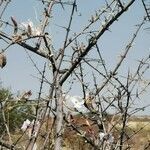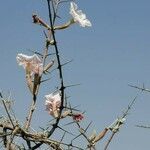Leaves petiolate; lamina 0.9–3.5 (4.7) × 0.5–1.7(2.3) cm. oblong to ovate or obovate, chartaceous to subcoriaceous, woolly on both surfaces greyish-green on the superior surface, more whitish on the inferior, apex rounded or rarely acute, base narrowly rounded to broadly cuneate, midrib and lateral nerves slightly sunken above, very prominent below as well as all the net-veining; margins irregularly toothed to crenate with small subcircular submarginal glands mainly from the base; petiole 1–5(7) mm. long.
A spiny shrub. It grows 4 m tall. The branches are woolly when young. The leaves are 1-3.5 cm long and 0.5-1.7 cm wide. The flowers are white and in the axils of leaves. The fruit capsule is 3-6 cm long by 1-2.4 cm wide. It has a grey-green coating. The seeds are 1.5 cm long by 2.5 cm wide. They are brownish.
Small tree or shrub, up to 4 m high. Leaves oblong to ovate or obovate, woolly on both surfaces, veins prominent below; margins irregularly toothed to crenate with small subcircular submarginal glands. Capsule warty, densely greyish green tomentose. Flowers white.
Calyx 18–40(47) mm. long, 5–9 mm. in diam. shortly splitting at one side conspicuously 5–6 ribbed; lobes 1–5(10) mm. long, filiform, woolly on the upper face, sparsely pilose in the lower.
Corolla tube 4–8.5 cm., long, narrow, greenish, glabrous outside, hirsute inside below the insertion of the stamens, or not; corolla lobes 1.5–3 cm. in diam., subcircular.
Ovary c. 2.5 mm. long, scabrous with thick dilated-base hairs; style 5.5–7.5 cm. long, glabrous or sparsely hairy on the lower half, thickened to a bilobed stigma.
Spiny shrub or small tree up to 4 m. high, much-branched from the base with divaricate woolly branches when young, becoming glabrous with age.
Flowers white, showy, in few-flowered fascicles or solitary on the young branches and in leaf axils; pedicels up to 5 mm. long, thick woolly.
Capsule 3–6 × 1–2.4 cm., shortly or longly beaked, stipitate; valves warty, densely greyish-green tomentose.
Filaments adnate to the corolla tube for all their length or free on the upper part; anthers 4–6 mm. long.
Seeds c. 1.5 × 2.5 cm. brownish including the hyaline membranous wing.



